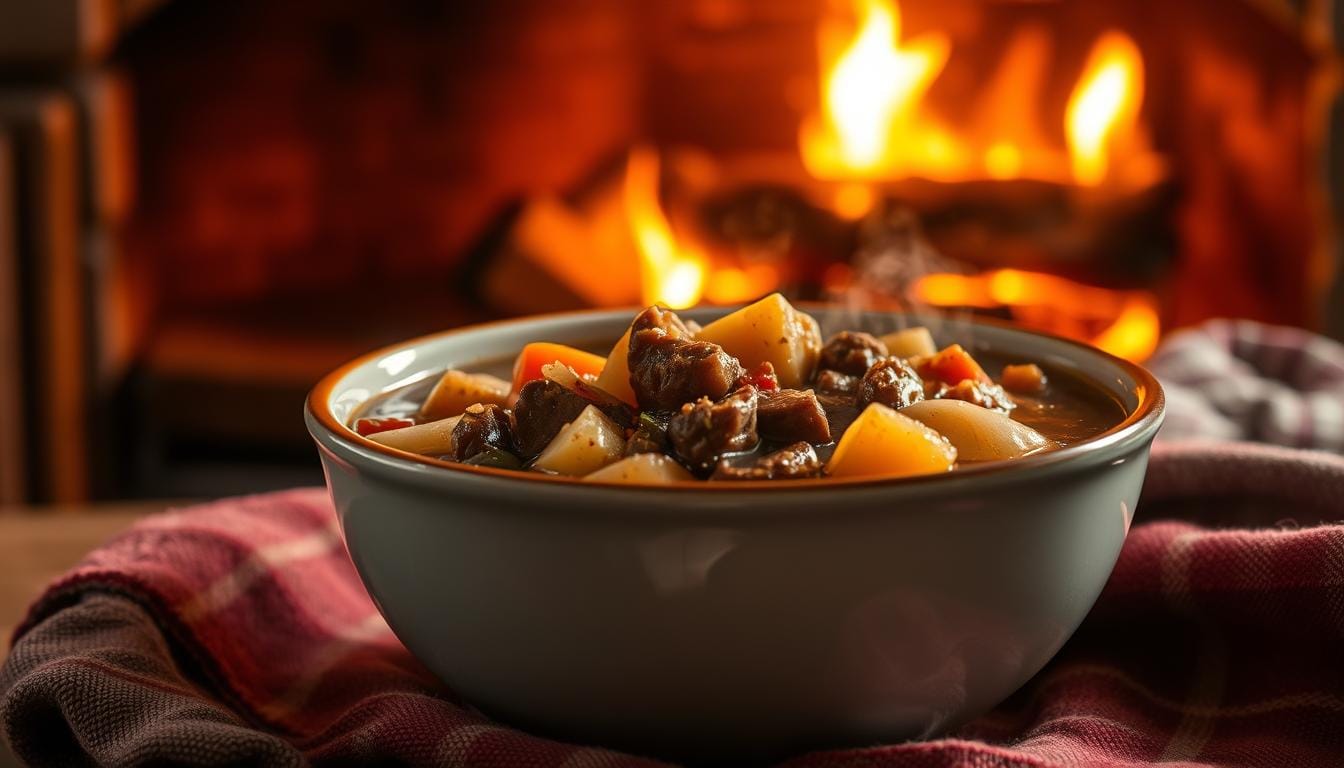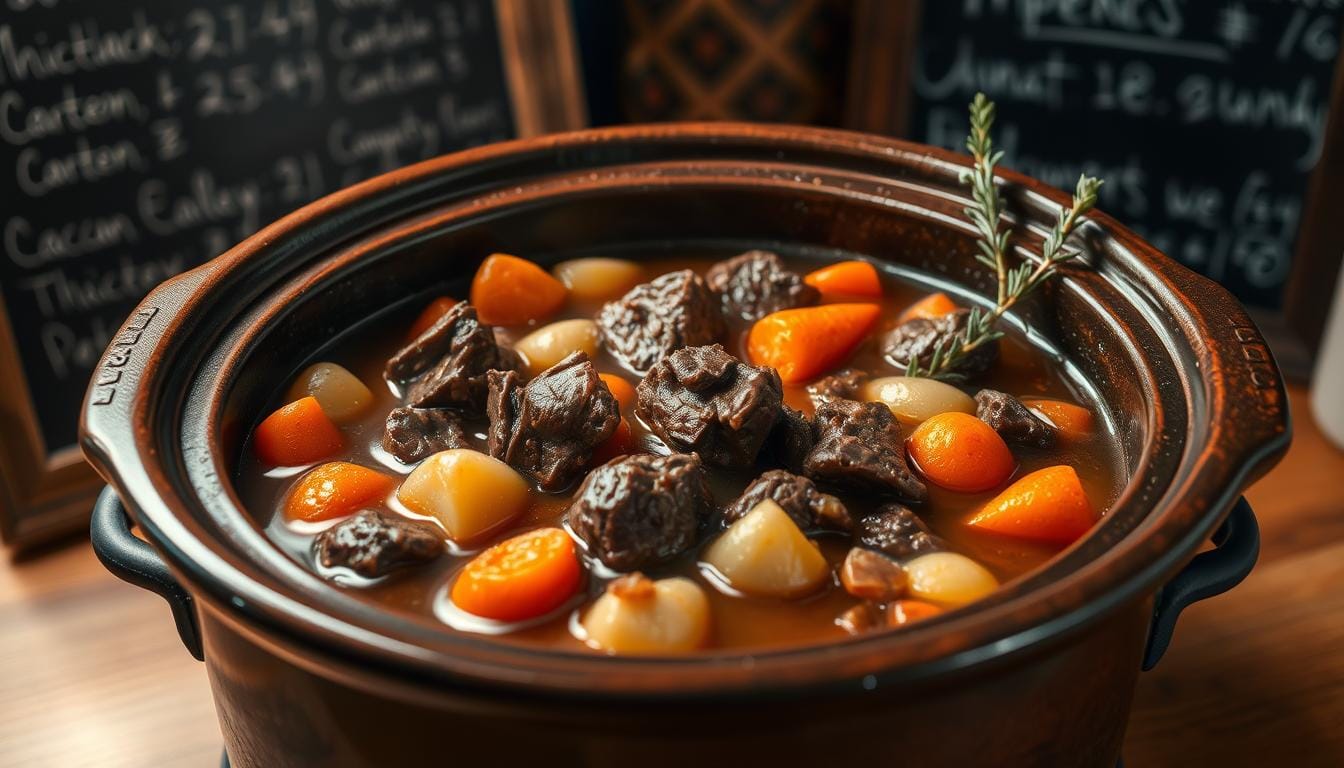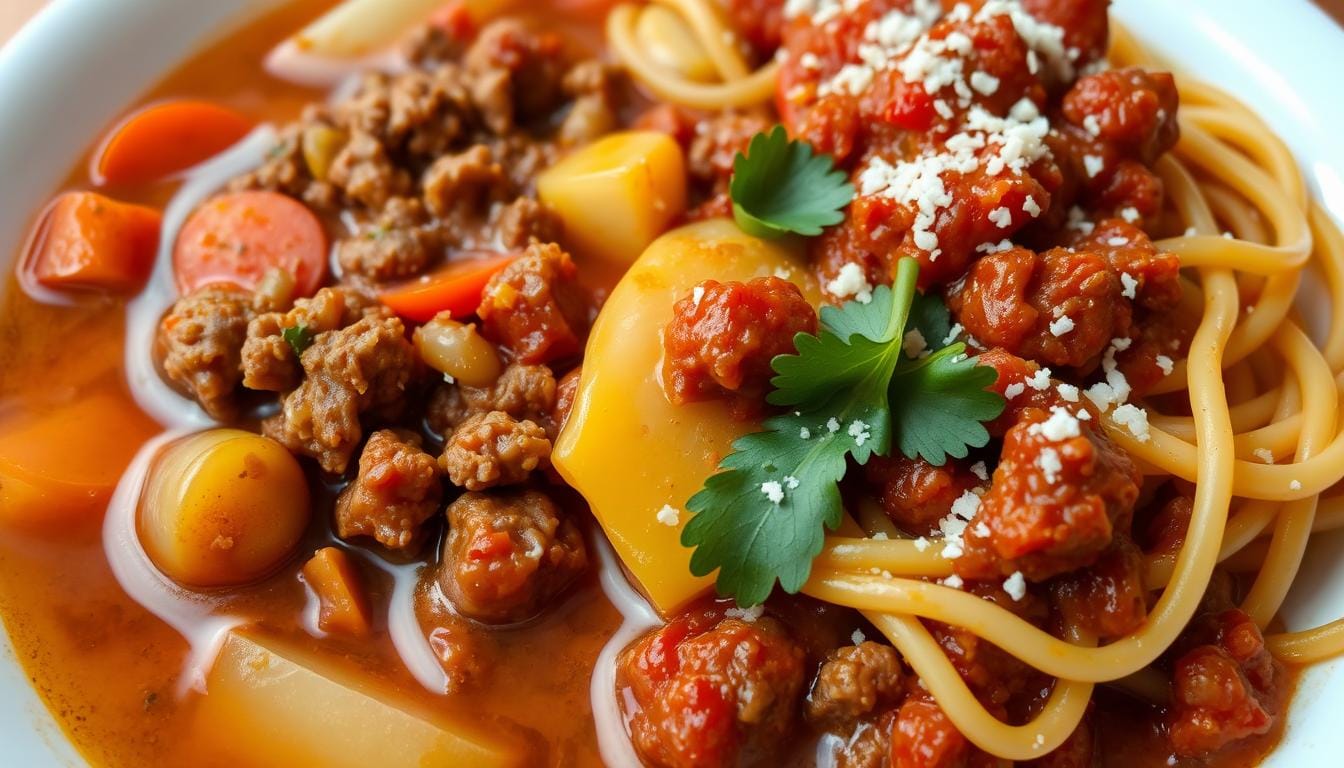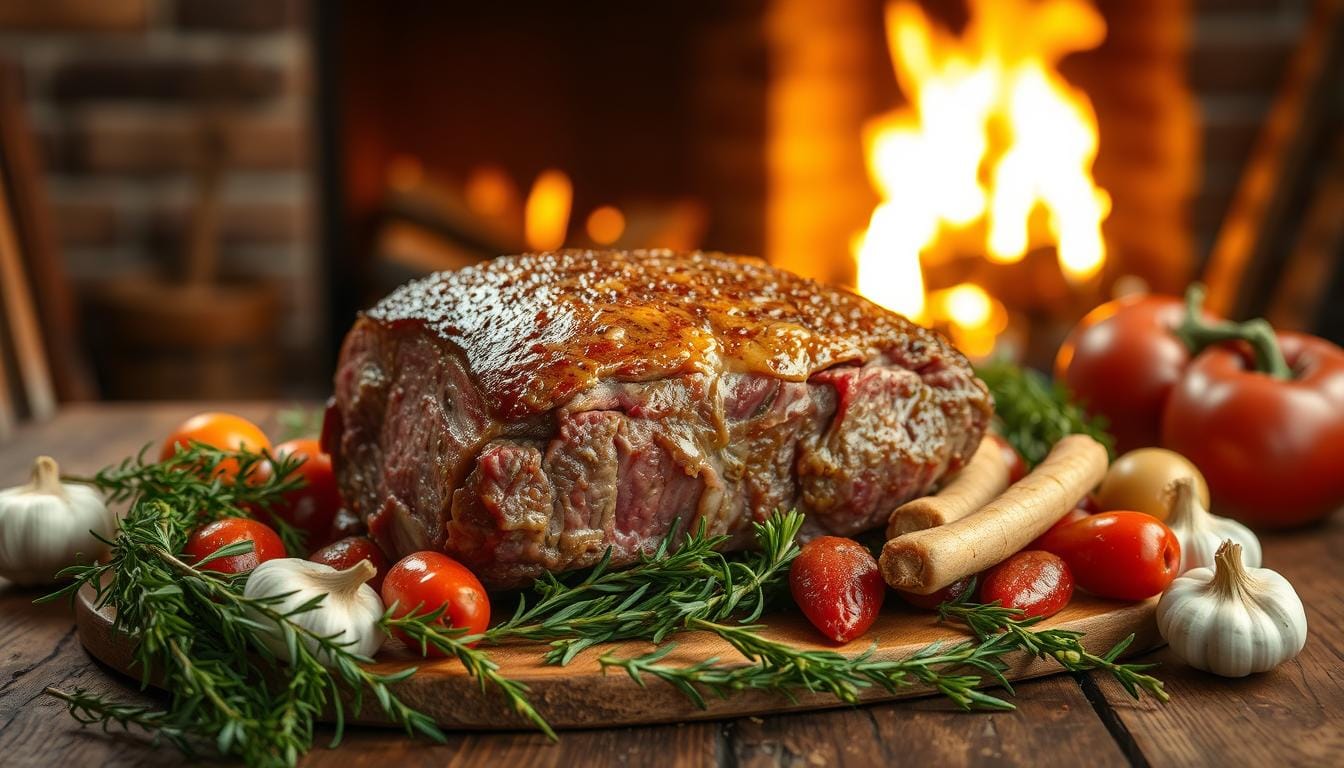Delicious Beef Stew Meat Recipes | 20 minutes
Table of Contents
Winter’s chill brings nothing like a warm beef stewhttps://www.fatirecipe.com/beef/. The smell of slow-cooked beef and veggies reminds me of my grandma’s kitchen. There, comfort was served in deep bowls.
Beef stew meat recipes are more than food. They’re like hugs that warm you inside. These dishes offer comfort, connection, and a sense of home in the cold months.
Whether you’re an experienced cook or new to the kitchen, these recipes will inspire you. They’ll help you make meals that bring families together. Explore new techniques, ingredients, and variations to enhance your winter dining.
Key Takeaways
- Beef stew is the ultimate winter comfort food
- Hearty beef stew recipes offer warmth and nutrition
- Cooking beef stew is an accessible skill for all home cooks
- Stew meat can be versatile across different cuisines
- Slow cooking develops deep, rich flavors
What is Beef Stew Meat?
Choosing the right meat is key to a great beef stew. The best cuts can turn a simple recipe into a cozy, memorable meal.
Introduction to Cuts of Beef
Not all beef cuts are the same for stewing. The best recipes need specific types that can handle long, slow cooking. These tough cuts become tender and full of flavor when cooked right.
Best Cuts for Stewing
- Chuck Roast: The top choice for beef stew, chuck roast is from the shoulder. It has great marbling.
- Round Cuts: Lean and affordable, great for budget-friendly recipes.
- Brisket: Another top pick, brisket is rich in flavor and tender when slow-cooked.
Nutritional Benefits of Beef Stew
Beef stew is not just tasty—it’s also full of nutrients. It’s packed with proteins, iron, zinc, and B-vitamins. The slow cooking method keeps nutrients in while making the meat tender.
| Beef Cut | Protein (per 100g) | Fat Content |
|---|---|---|
| Chuck Roast | 26g | Medium |
| Round Cut | 23g | Low |
Picking the right beef stew meat ensures your dish is both healthy and tasty. Knowing these details helps you make meals as good as a restaurant’s in your own kitchen.
Essential Ingredients for Beef Stew
Making a tasty classic beef stew starts with picking the right ingredients. Your easy beef stew recipes need the right parts to create deep, rich flavors. Let’s look at the key ingredients that make a simple meal into a cozy dish.
Basic Ingredients for a Perfect Stew
Every great classic beef stew starts with a few important ingredients. Here’s what you’ll need:
- High-quality beef chuck roast
- Fresh root vegetables
- Robust potatoes
- Onions and garlic
- Olive oil
Herbs and Spices to Elevate Flavor
The secret to unforgettable easy beef stew recipes is in your spice choice. Think about these flavor boosters:
| Herb/Spice | Flavor Profile |
|---|---|
| Thyme | Earthy and slightly minty |
| Rosemary | Woody and aromatic |
| Bay Leaves | Subtle herbal notes |
| Black Pepper | Warm and slightly spicy |
Choosing the Right Broth
Your broth is the base of a classic beef stew. Beef stock gives the best flavor, but you can try bone broth for more richness. Choose low-sodium options to control the salt in your easy beef stew recipes.
Classic Beef Stew Recipe
Making a delicious classic beef stew is easy. It’s great for a cold winter day or a comforting dinner. This recipe will help you make the perfect slow cooker beef stew.
Cooking Methods: Choosing Your Approach
There are two main ways to cook a classic beef stew:
- Stovetop Method: Quick and hands-on cooking
- Slow Cooker Method: Convenient and low-maintenance
Essential Ingredients
| Ingredient | Quantity | Purpose |
|---|---|---|
| Beef Chuck | 2 lbs | Main protein |
| Potatoes | 3 medium | Hearty base |
| Carrots | 4 whole | Added nutrition |
| Beef Broth | 4 cups | Flavor base |
Step-by-Step Cooking Instructions
- Cut beef into 1-inch cubes
- Season meat with salt and pepper
- Brown meat in a hot pan
- Transfer to slow cooker
- Add vegetables and broth
- Cook on low for 8 hours
Flavor-Perfecting Tips
To make your slow cooker beef stew even better, try these tips:
- Use chuck roast for maximum tenderness
- Sear meat before slow cooking
- Add fresh herbs in the last hour
- Let stew rest for 15 minutes before serving
Your classic beef stew will be full of rich flavors and tender meat. The slow cooking makes it perfect for any occasion.
Hearty Vegetable Additions
Creating the perfect hearty beef stew is more than just using quality beef. Vegetables are key to making a great stew. They add depth, nutrition, and flavor.
Best Vegetables for Your Stew
Choosing the right vegetables can make your beef stew stand out. Here are some top picks:
- Root Vegetables: Carrots, parsnips, and turnips add rich, earthy flavors
- Hearty Potatoes: Russet or red potatoes make the stew creamy and filling
- Aromatic Additions: Onions and celery give a strong flavor base
- Green Options: Peas or green beans add color and freshness
Vegetable Preparation Techniques
Proper preparation is key for vegetables to match the beef stew. Cut them into uniform chunks for even cooking. Use larger pieces for slow-cooked stews to keep texture.
Timing is Everything
Knowing when to add vegetables is crucial. Harder vegetables like carrots and potatoes go in early. Add peas or green beans last to keep them crisp.
With the right vegetable choices and timing, your hearty beef stew will impress everyone.
Alternative Beef Stew Variations
Beef stew meat recipes are incredibly versatile, found in cuisines worldwide. Exploring these variations turns your traditional beef stew into a thrilling journey. Each one adds new flavors and ingredients, making the dish even more comforting.
Discover these international beef bourguignon recipes. They show how beef stew meat can be transformed in amazing ways.
Asian-Inspired Beef Stew
Asian cuisines add bold, complex flavors to beef stew. Your stew can include:
- Soy sauce
- Ginger
- Star anise
- Rice wine
These ingredients make a stew rich with umami, unlike anything from the West.
Mexican Beef Stew
Mexican beef stew recipes add vibrant spices and chili peppers. Try adding:
- Chipotle peppers
- Cumin
- Cilantro
- Lime juice
This makes a stew that’s spicy and tangy, waking up your taste buds.
Mediterranean Beef Stew
Mediterranean versions focus on fresh herbs and bright flavors. Key ingredients are:
- Olives
- Rosemary
- Tomatoes
- Red wine
This approach makes a stew that’s light, herbaceous, and both rustic and refined.
Cooking Tips for Tender Meat

Turning tough beef into tender stews is all about the right techniques. Knowing the best cuts and how to prepare them makes a big difference. This can take your braised beef recipes from good to great.
To get tender, flavorful meat, follow some key steps. Chefs have perfected these over years. Your goal is to soften the meat and add deep flavor to every bite.
Marinating Your Beef
Marinating is a great way to tenderize and flavor your meat. Here are some tips:
- Use acidic ingredients like vinegar or citrus juice
- Add enzymatic ingredients such as pineapple or papaya
- Marinate for 2-12 hours depending on meat thickness
Browning Techniques
Browning is key for rich flavors in your stew. Dry the meat before searing. This helps get a perfect golden-brown crust.
| Meat Cut | Ideal Browning Time | Recommended Temperature |
|---|---|---|
| Chuck Roast | 3-4 minutes per side | High heat (around 400°F) |
| Brisket | 4-5 minutes per side | Medium-high heat (375°F) |
| Short Ribs | 2-3 minutes per side | High heat (425°F) |
Cooking Times for Tough Cuts
Tough cuts need slow cooking to become tender. Low and slow is the secret to making tough beef cuts tender and delicious.
- Chuck roast: 2-3 hours of slow cooking
- Brisket: 3-4 hours at low temperature
- Short ribs: 2.5-3 hours until fork-tender
Learning these techniques will help you make braised beef recipes that wow everyone. Your family and friends will love it.
Serving Suggestions
Creating the perfect beef pot roast recipes is more than cooking. It’s about making a meal that pleases all senses. Your hearty beef stew should have a special serving that makes it unforgettable.
Ideal Side Dishes to Complement Your Stew
Choosing the right side dishes can make your beef stew stand out. Here are some tasty options:
- Creamy mashed potatoes
- Roasted root vegetables
- Buttered egg noodles
- Crisp green salad
Perfect Bread Pairings
The rich gravy of a hearty beef stew needs bread that can soak it up. Try these:
- Crusty sourdough
- Warm cornbread
- Rustic French baguette
- Garlic-herb focaccia
Creative Garnishes to Impress
Make your beef pot roast recipes special with these garnishes:
- Fresh chopped parsley
- Crispy fried onions
- Grated sharp cheddar
- Cracked black pepper
Your hearty beef stew is more than food. It’s a culinary adventure waiting to be enjoyed and shared.
Freezing and Storing Beef Stew
Keeping your beef stew fresh requires the right storage methods. Learning how to freeze and store your stew ensures you can enjoy it anytime.
Best Practices for Freezing
Freezing your beef stew is a great way to keep it fresh for longer. Here are some important steps to follow:
- Cool the stew completely before freezing
- Use airtight containers or heavy-duty freezer bags
- Leave about 1/2 inch of space at the top for expansion
- Label containers with the date of freezing
Thawing and Reheating Tips
Thawing your beef stew correctly is key to keeping its taste and texture. Slow and steady wins the race when defrosting:
- Transfer frozen stew to the refrigerator the night before
- Reheat slowly on the stovetop over medium-low heat
- Stir occasionally to distribute heat evenly
- Add a splash of broth if the stew seems too thick
Shelf Life of Beef Stew
Knowing how long your beef stew lasts helps avoid waste and keeps it safe to eat. Here’s a quick guide:
| Storage Location | Maximum Storage Time |
|---|---|
| Refrigerator | 3-4 days |
| Freezer | 2-3 months |
Pro tip: Always trust your senses. If the stew smells off or shows signs of freezer burn, it’s best to discard it and make a fresh batch of your favorite beef stew recipe.
Customizing Your Beef Stew
Beef chuck recipes are super versatile. You can turn a classic hearty beef stew into something special. Whether you need to make it diet-friendly or just want to try new flavors, it’s easy to make your stew unique.
Changing your beef stew to fit dietary needs doesn’t mean it has to taste bad. With a few simple swaps, you can make a dish that everyone will love.
Gluten-Free Options
Even without gluten, your stew can still be full of flavor. Try these swaps:
- Use cornstarch instead of wheat flour for thickening
- Switch to gluten-free tamari for soy sauce
- Make sure your beef broth is gluten-free
Dairy-Free Variations
Dairy-free folks can enjoy a creamy stew too. Here’s how:
- Use coconut milk instead of heavy cream
- Add cashew cream for extra creaminess
- Try nutritional yeast for a cheesy taste
Adding Heat: Spicy Beef Stew Ideas
For those who love spice, here are some fiery ideas:
| Spice Level | Recommended Ingredients |
|---|---|
| Mild | Smoked paprika, black pepper |
| Medium | Jalapeños, chipotle peppers |
| Hot | Habanero, ghost pepper sauce |
Try these tweaks to make a stew that’s just right for you. The most important thing is to have fun and be creative!
Common Mistakes to Avoid
Making a great classic beef stew is more than just mixing ingredients. Even skilled cooks can make mistakes that ruin the dish. Knowing these common errors can help you improve your cooking and make a delicious meal every time.
Overcooking the Meat: A Tender Tragedy
One big mistake in beef stew is overcooking the meat. Cuts like chuck or round are great for stewing, but need careful cooking. Cooking at too high a temperature or for too long can make the meat tough and unpleasant. Cook your stew on low heat to make the meat tender and flavorful.
The Seasoning Dilemma
Not seasoning properly is another mistake that can make your stew taste bland. Salt and pepper are just the start. Here are some seasoning tips:
- Layer flavors by seasoning meat before browning
- Use fresh herbs like thyme and rosemary
- Include aromatic vegetables like onions and garlic
- Experiment with bay leaves or red wine for depth
Ingredient Selection Matters
Not all ingredients are the same in a classic beef stew. The wrong meat or low-quality veggies can ruin your dish. Choose well-marbled beef cuts that get tender in slow cooking. Use fresh, seasonal veggies for the best taste and texture.
Avoiding these mistakes can turn your beef stew into a standout dish. With practice, patience, and attention to detail, you’ll create unforgettable meals.
Conclusion: Enjoying Your Beef Stew
Learning to make beef stew is more than just a recipe. It’s a journey that connects you to home cooking traditions. Your hearty beef stew can be the heart of family gatherings, warming hearts and bringing people together.
Every time you make beef stew, you learn something new. Trying different ingredients and methods lets you create a dish that’s uniquely yours. Whether you stick to classics or try new things, the most important thing is to cook with passion and creativity.
Final Thoughts on Preparation
Great beef stew is about the love you put into it, not just the recipe. Choose the best beef, take your time to make flavors rich, and make it your own. Your family and friends will love the effort and warmth you put into every dish.
Sharing Your Recipes with Friends
Cooking is a great way to connect with others. Share your beef stew recipes with friends, swap tips, and start new traditions. Your cooking adventures can bring joy to those around you, making every meal a celebration.
Making Beef Stew a Family Tradition
By making beef stew a staple, you keep a timeless tradition alive. Each pot of stew has its own story—of comfort, nourishment, and the joy of home-cooked meals. So, gather your ingredients, get ready to cook, and start making delicious memories.
FAQ
What is the best cut of beef for stew?
Chuck roast is the top choice for beef stew. It’s from the cow’s shoulder and has lots of marbling. This marbling makes the meat tender and flavorful. Other great options are bottom round, brisket, and short ribs.
How long should I cook beef stew?
Beef stew needs to cook slowly for tenderness. In a slow cooker, cook for 6-8 hours on low. On the stovetop or in the oven, simmer for 2-3 hours at low heat. The meat should be so tender it falls apart easily.
Can I make beef stew without a slow cooker?
Yes, you can make beef stew without a slow cooker. Use a heavy pot or Dutch oven on the stovetop. Or, cook it in the oven in a covered dish. Brown the meat first, then simmer until it’s tender.
How can I thicken my beef stew?
There are many ways to thicken beef stew. Use flour or cornstarch as a roux or slurry. Add potato or pureed veggies, or simmer uncovered to reduce. Crushing cooked potatoes can also thicken it.
Is beef stew healthy?
Beef stew is nutritious. It’s full of protein, iron, and zinc. It also has veggies for vitamins and fiber. Use lean beef, add lots of veggies, and watch the salt.
Can I freeze beef stew?
Yes, beef stew freezes well. Cool it first, then put it in airtight containers or bags. It keeps for 3-4 months in the freezer. Thaw it in the fridge and reheat gently.
What are the best vegetables for beef stew?
Carrots, potatoes, celery, and onions are classic. Add parsnips, turnips, mushrooms, or peas for more flavor and nutrition. Pick veggies that stay firm during long cooking.
How can I make my beef stew more flavorful?
To boost flavor, brown the meat first. Use rich beef broth and add herbs like thyme and bay leaves. Red wine or tomato paste can also help. Season well with salt and pepper. Feel free to try different spices and aromatics.







